2014 DODGE GRAND CARAVAN radiator cap
[x] Cancel search: radiator capPage 562 of 698
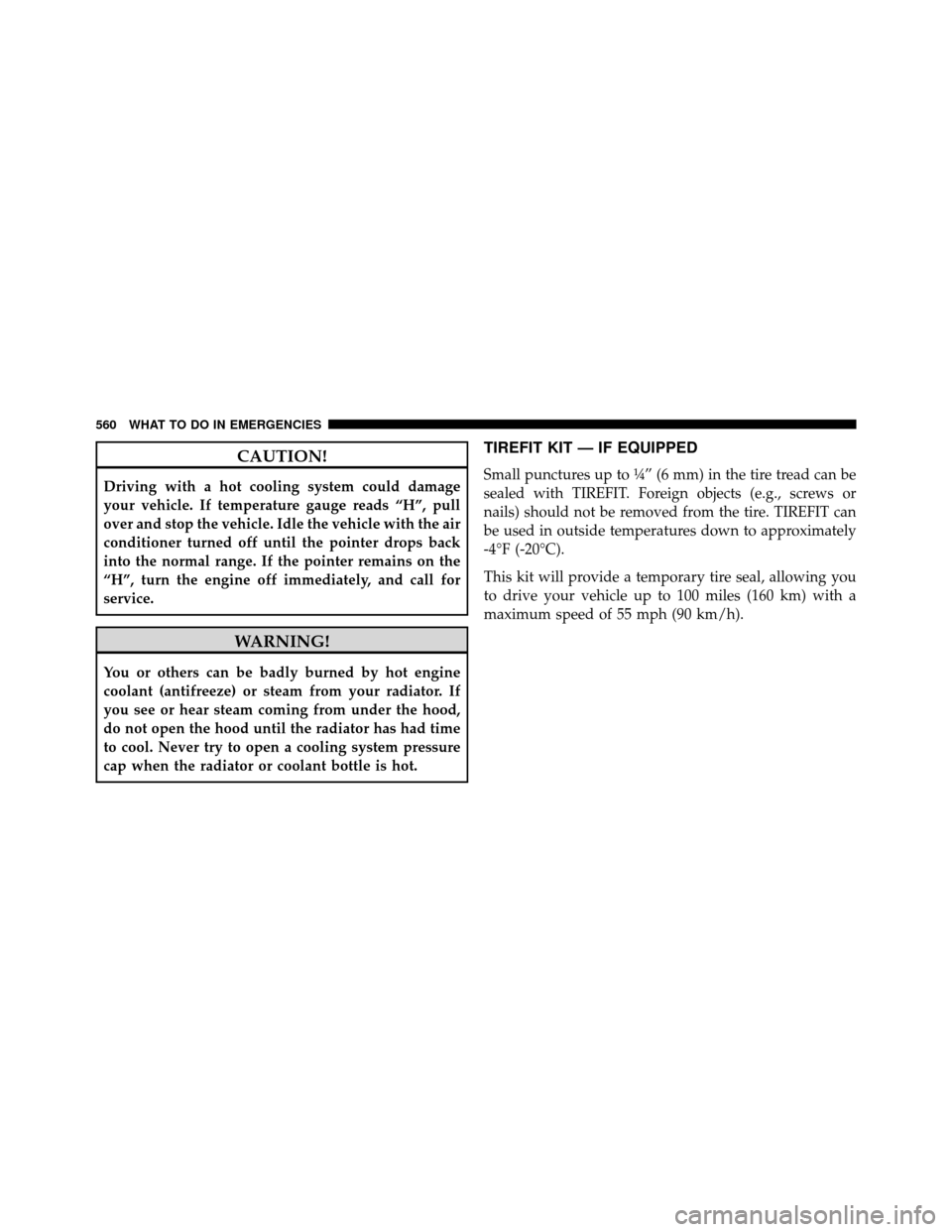
CAUTION!
Driving with a hot cooling system could damage
your vehicle. If temperature gauge reads “H”, pull
over and stop the vehicle. Idle the vehicle with the air
conditioner turned off until the pointer drops back
into the normal range. If the pointer remains on the
“H”, turn the engine off immediately, and call for
service.
WARNING!
You or others can be badly burned by hot engine
coolant (antifreeze) or steam from your radiator. If
you see or hear steam coming from under the hood,
do not open the hood until the radiator has had time
to cool. Never try to open a cooling system pressure
cap when the radiator or coolant bottle is hot.
TIREFIT KIT — IF EQUIPPED
Small punctures up to ¼” (6 mm) in the tire tread can be
sealed with TIREFIT. Foreign objects (e.g., screws or
nails) should not be removed from the tire. TIREFIT can
be used in outside temperatures down to approximately
-4°F (-20°C).
This kit will provide a temporary tire seal, allowing you
to drive your vehicle up to 100 miles (160 km) with a
maximum speed of 55 mph (90 km/h).
560 WHAT TO DO IN EMERGENCIES
Page 624 of 698

After the engine has warmed, operate the defroster for a
few minutes to reduce the possibility of smearing or
freezing the fluid on the cold windshield. MOPAR® All
Weather Windshield Washer Solution or equivalent, used
with water as directed on the container, aids cleaning
action, reduces the freezing point to avoid line clogging,
and is not harmful to paint or trim.
Cooling System
WARNING!
•When working near the radiator cooling fan,
disconnect the fan motor lead or turn the ignition
switch to the OFF position. The fan is temperature
controlled and can start at anytime the ignition
switch is in the ON position.
(Continued)
WARNING! (Continued)
•You or others can be badly burned by hot engine
coolant (antifreeze) or steam from your radiator. If
you see or hear steam coming from under the hood,
do not open the hood until the radiator has had
time to cool. Never try to open a cooling system
pressure cap when the radiator is hot.
Coolant Checks
Check the engine coolant (antifreeze) protection every 12
months (before the onset of freezing weather, where
applicable). If the engine coolant (antifreeze) is dirty, the
system should be drained, flushed, and refilled with
fresh OAT coolant (conforming to MS-12106) only by an
authorized dealer. Check the front of the A/C condenser
for any accumulation of bugs, leaves, etc. If dirty, clean by
gently spraying water from a garden hose vertically
down the face of the condenser.
622 MAINTAINING YOUR VEHICLE
Page 625 of 698
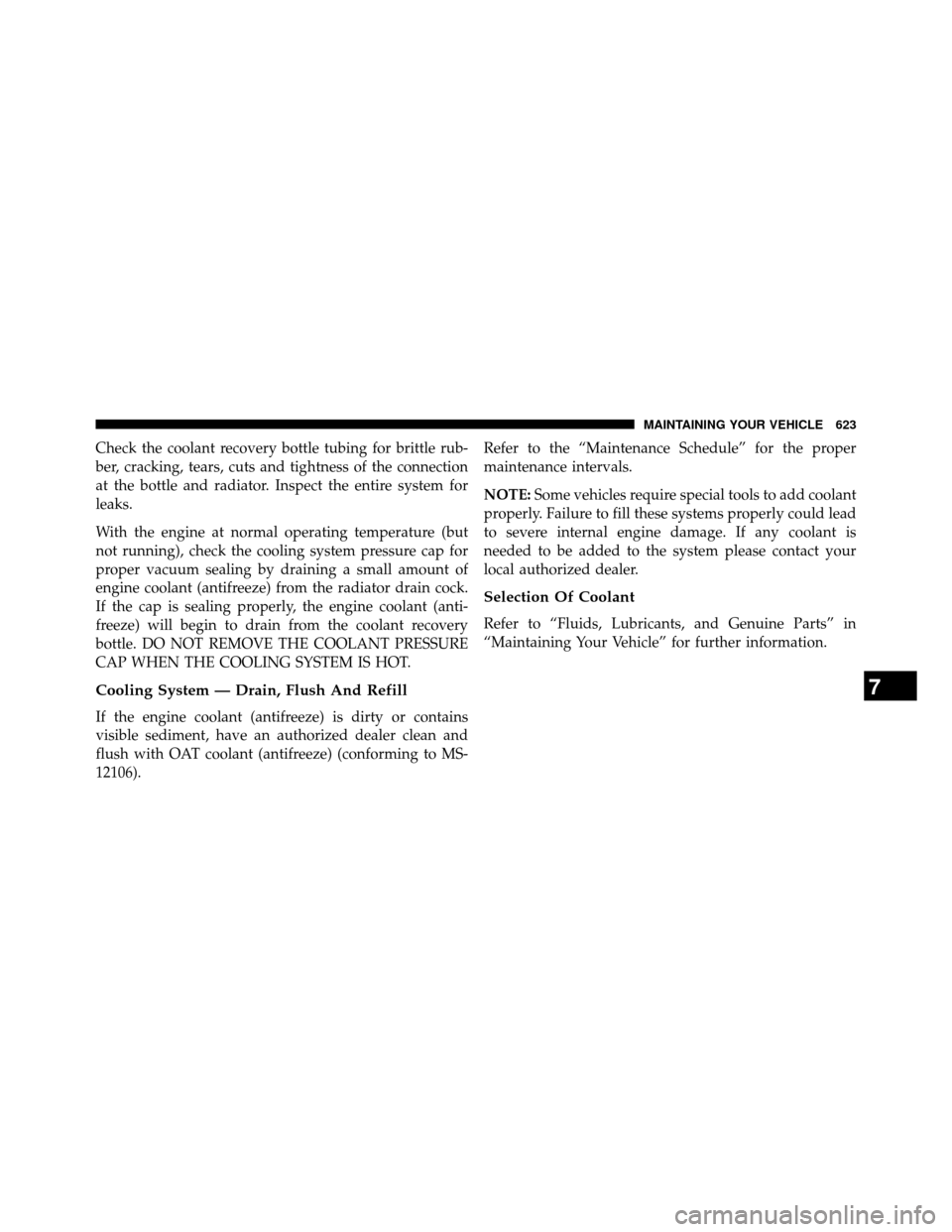
Check the coolant recovery bottle tubing for brittle rub-
ber, cracking, tears, cuts and tightness of the connection
at the bottle and radiator. Inspect the entire system for
leaks.
With the engine at normal operating temperature (but
not running), check the cooling system pressure cap for
proper vacuum sealing by draining a small amount of
engine coolant (antifreeze) from the radiator drain cock.
If the cap is sealing properly, the engine coolant (anti-
freeze) will begin to drain from the coolant recovery
bottle. DO NOT REMOVE THE COOLANT PRESSURE
CAP WHEN THE COOLING SYSTEM IS HOT.
Cooling System — Drain, Flush And Refill
If the engine coolant (antifreeze) is dirty or contains
visible sediment, have an authorized dealer clean and
flush with OAT coolant (antifreeze) (conforming to MS-
12106).Refer to the “Maintenance Schedule” for the proper
maintenance intervals.
NOTE:
Some vehicles require special tools to add coolant
properly. Failure to fill these systems properly could lead
to severe internal engine damage. If any coolant is
needed to be added to the system please contact your
local authorized dealer.
Selection Of Coolant
Refer to “Fluids, Lubricants, and Genuine Parts” in
“Maintaining Your Vehicle” for further information.
7
MAINTAINING YOUR VEHICLE 623
Page 628 of 698
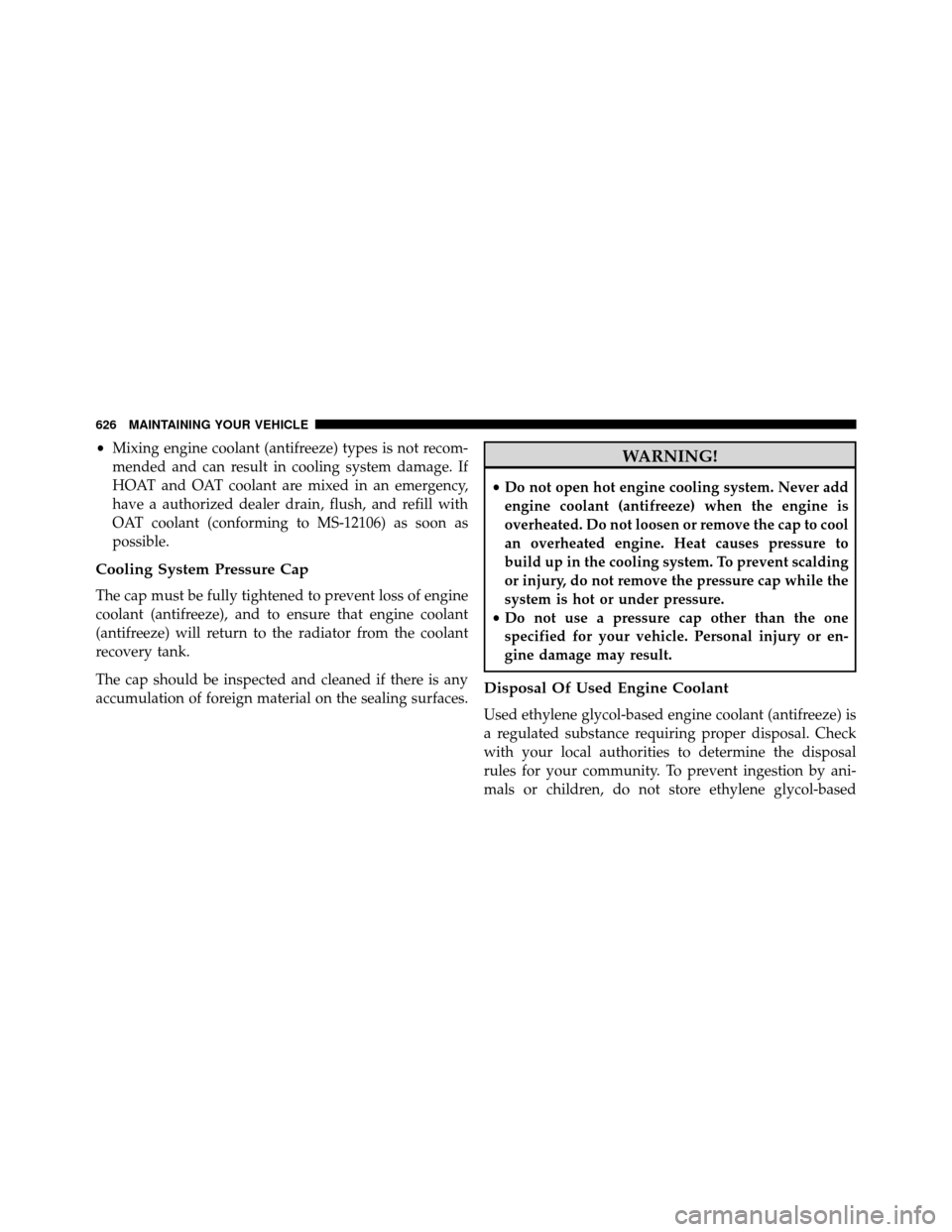
•Mixing engine coolant (antifreeze) types is not recom-
mended and can result in cooling system damage. If
HOAT and OAT coolant are mixed in an emergency,
have a authorized dealer drain, flush, and refill with
OAT coolant (conforming to MS-12106) as soon as
possible.
Cooling System Pressure Cap
The cap must be fully tightened to prevent loss of engine
coolant (antifreeze), and to ensure that engine coolant
(antifreeze) will return to the radiator from the coolant
recovery tank.
The cap should be inspected and cleaned if there is any
accumulation of foreign material on the sealing surfaces.
WARNING!
• Do not open hot engine cooling system. Never add
engine coolant (antifreeze) when the engine is
overheated. Do not loosen or remove the cap to cool
an overheated engine. Heat causes pressure to
build up in the cooling system. To prevent scalding
or injury, do not remove the pressure cap while the
system is hot or under pressure.
• Do not use a pressure cap other than the one
specified for your vehicle. Personal injury or en-
gine damage may result.
Disposal Of Used Engine Coolant
Used ethylene glycol-based engine coolant (antifreeze) is
a regulated substance requiring proper disposal. Check
with your local authorities to determine the disposal
rules for your community. To prevent ingestion by ani-
mals or children, do not store ethylene glycol-based
626 MAINTAINING YOUR VEHICLE
Page 629 of 698
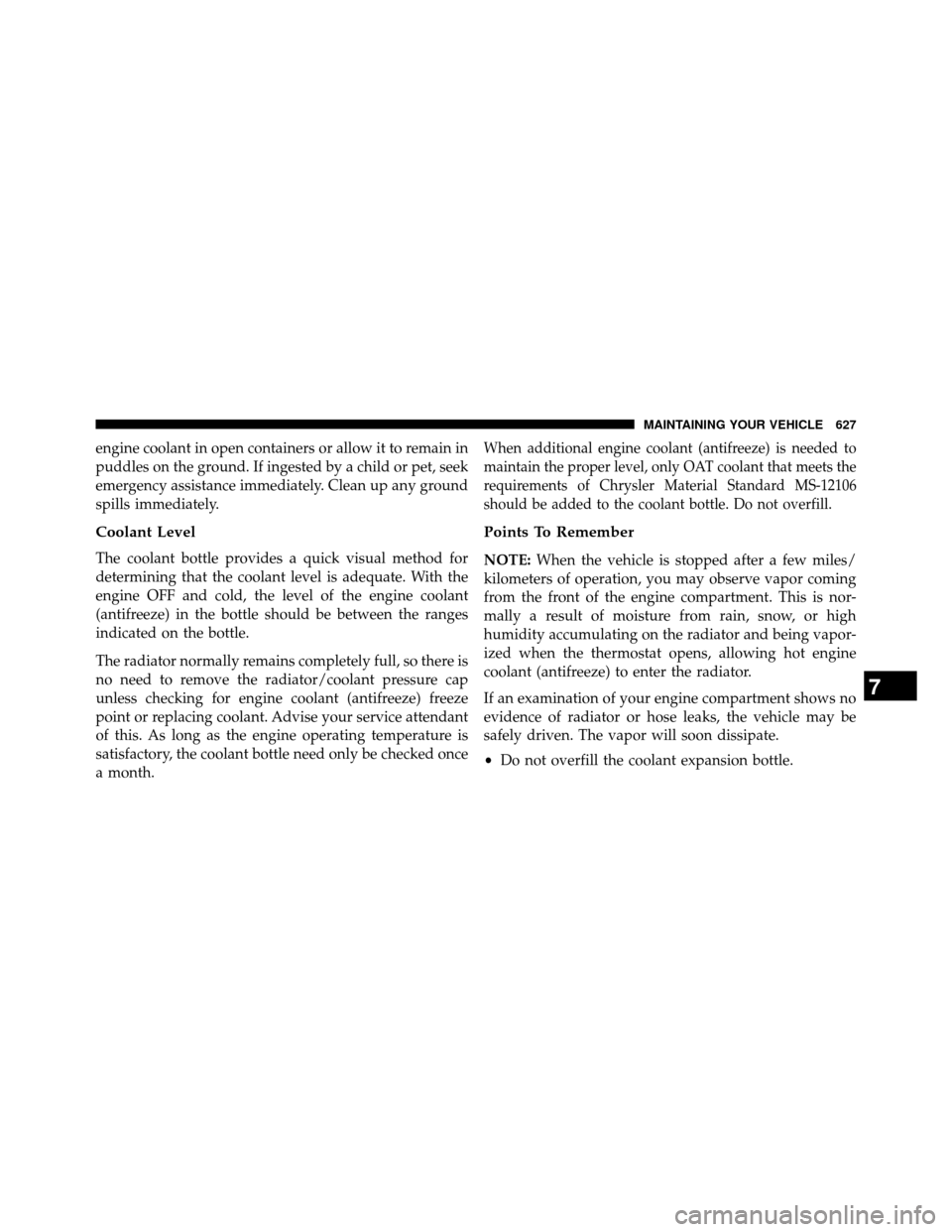
engine coolant in open containers or allow it to remain in
puddles on the ground. If ingested by a child or pet, seek
emergency assistance immediately. Clean up any ground
spills immediately.
Coolant Level
The coolant bottle provides a quick visual method for
determining that the coolant level is adequate. With the
engine OFF and cold, the level of the engine coolant
(antifreeze) in the bottle should be between the ranges
indicated on the bottle.
The radiator normally remains completely full, so there is
no need to remove the radiator/coolant pressure cap
unless checking for engine coolant (antifreeze) freeze
point or replacing coolant. Advise your service attendant
of this. As long as the engine operating temperature is
satisfactory, the coolant bottle need only be checked once
a month.
When additional engine coolant (antifreeze) is needed to
maintain the proper level, only OAT coolant that meets the
requirements of Chrysler Material Standard MS-12106
should be added to the coolant bottle. Do not overfill.
Points To Remember
NOTE:When the vehicle is stopped after a few miles/
kilometers of operation, you may observe vapor coming
from the front of the engine compartment. This is nor-
mally a result of moisture from rain, snow, or high
humidity accumulating on the radiator and being vapor-
ized when the thermostat opens, allowing hot engine
coolant (antifreeze) to enter the radiator.
If an examination of your engine compartment shows no
evidence of radiator or hose leaks, the vehicle may be
safely driven. The vapor will soon dissipate.
• Do not overfill the coolant expansion bottle.
7
MAINTAINING YOUR VEHICLE 627
Page 679 of 698

Adding Fluid..........................631
Fluid and Filter Changes ..................632
Fluid Change ..........................632
Fluid Level Check .......................631
FluidType ............................630
Gear Ranges ...........................466
Special Additives .......................631
Torque Converter .......................474
Auto Up Power Windows ....................43
Battery .................................616
Jump Starting ..........................593
Keyless Transmitter Replacement (RKE) ........28
Saving Feature (Protection) ................231
Belts, Seat ...............................121
Body Mechanism Lubrication .................620
B-Pillar Location ..........................501
Brake Assist System .......................485
Brake Control System, Electronic ..............484Brake Fluid
.............................655
Brake System ............................628
Fluid Check ...........................629
Parking ..............................479
Warning Light .........................322
Brake/Transmission Interlock .................464
Bulb Replacement .........................649
Bulbs,Light.............................124
Calibration, Compass ......................342
Camera, Rear ............................254
Capacities, Fluid ..........................653
Caps, Filler Fuel .................................538
Power Steering .........................478
Radiator (Coolant Pressure) ................626
Carbon Monoxide Warning ..................120
Cargo Area Features .......................297
Cargo Compartment .......................297
10
INDEX 677
Page 681 of 698
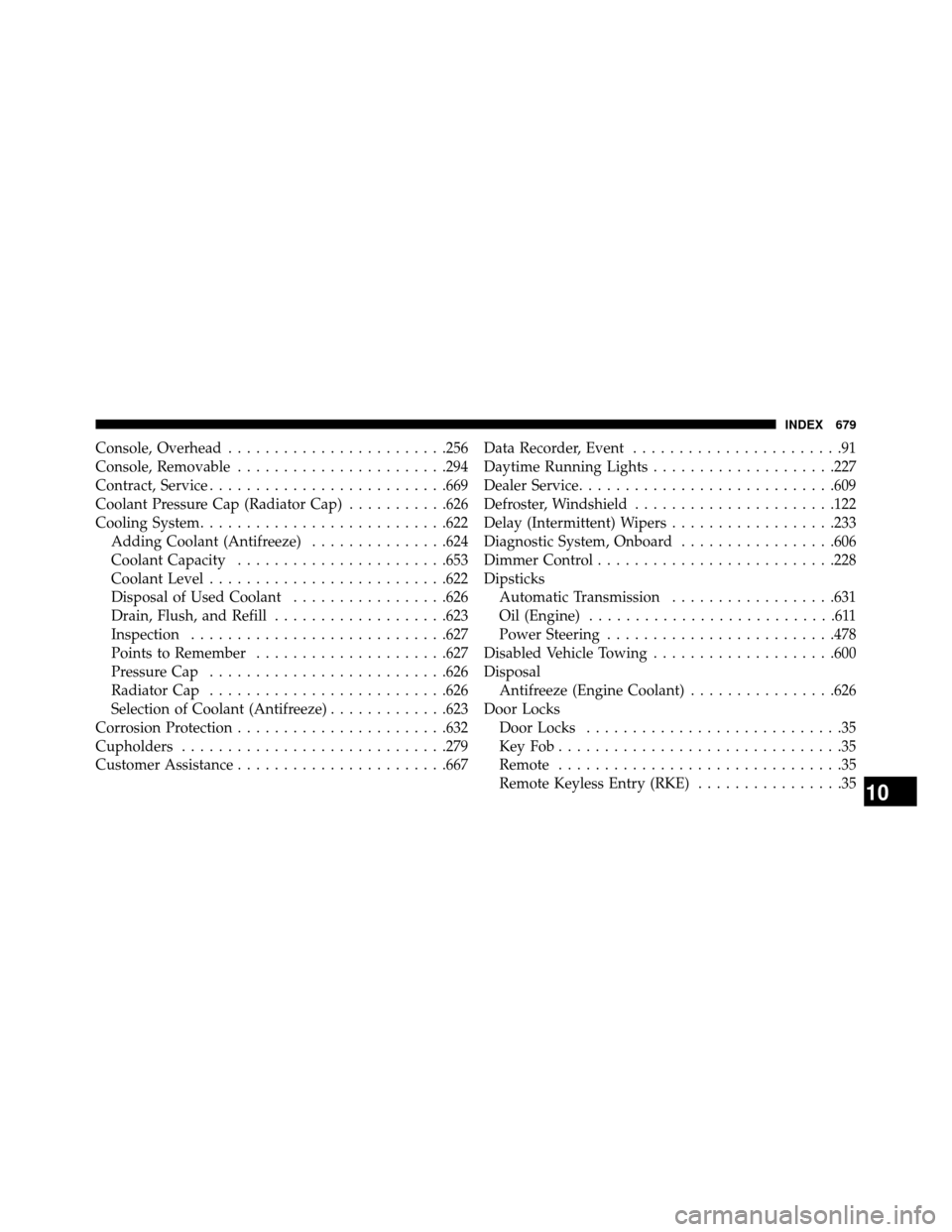
Console, Overhead........................256
Console, Removable .......................294
Contract, Service ..........................669
Coolant Pressure Cap (Radiator Cap) ...........626
Cooling System ...........................622
Adding Coolant (Antifreeze) ...............624
Coolant Capacity .......................653
Coolant Level ..........................622
Disposal of Used Coolant .................626
Drain, Flush, and Refill ...................623
Inspection ............................627
Points to Remember .....................627
Pressure Cap ..........................626
Radiator Cap ..........................626
Selection of Coolant (Antifreeze) .............623
Corrosion Protection .......................632
Cupholders .............................279
Customer Assistance .......................667 Data Recorder, Event
.......................91
Daytime Running Lights ....................227
Dealer Service ............................609
Defroster, Windshield ......................122
Delay (Intermittent) Wipers ..................233
Diagnostic System, Onboard .................606
Dimmer Control ..........................228
Dipsticks Automatic Transmission ..................631
Oil (Engine) ...........................611
Power Steering .........................478
Disabled Vehicle Towing ....................600
Disposal Antifreeze (Engine Coolant) ................626
Door Locks Door Locks ............................35
KeyFob...............................35
Remote ...............................35
Remote Keyless Entry (RKE) ................35
10
INDEX 679
Page 690 of 698
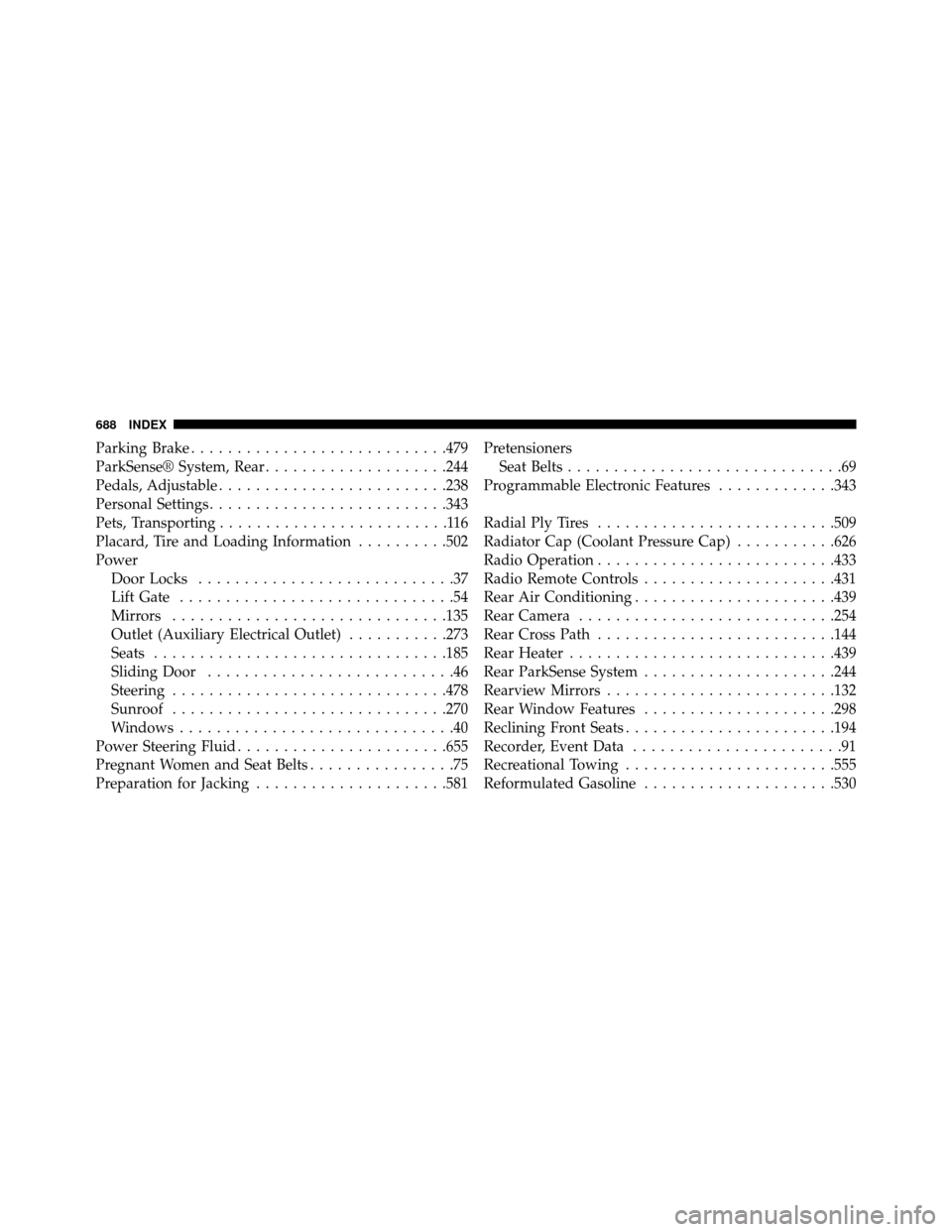
Parking Brake............................479
ParkSense® System, Rear ....................244
Pedals, Adjustable .........................238
Personal Settings ..........................343
Pets, Transporting .........................116
Placard, Tire and Loading Information ..........502
Power Door Locks ............................37
Lift Gate ..............................54
Mirrors ..............................135
Outlet (Auxiliary Electrical Outlet) ...........273
Seats ................................185
Sliding Door ...........................46
Steering ..............................478
Sunroof ..............................270
Windows ..............................40
Power Steering Fluid .......................655
Pregnant Women and Seat Belts ................75
Preparation for Jacking .....................581 Pretensioners
Seat Belts ..............................69
Programmable Electronic Features .............343
Radial Ply Tires ..........................509
Radiator Cap (Coolant Pressure Cap) ...........626
Radio Operation ..........................433
Radio Remote Controls .....................431
Rear Air Conditioning ......................439
Rear Camera ............................254
Rear Cross Path ..........................144
Rear Heater .............................439
Rear ParkSense System .....................244
Rearview Mirrors .........................132
Rear Window Features .....................298
Reclining Front Seats .......................194
Recorder, Event Data .......................91
Recreational Towing .......................555
Reformulated Gasoline .....................530
688 INDEX